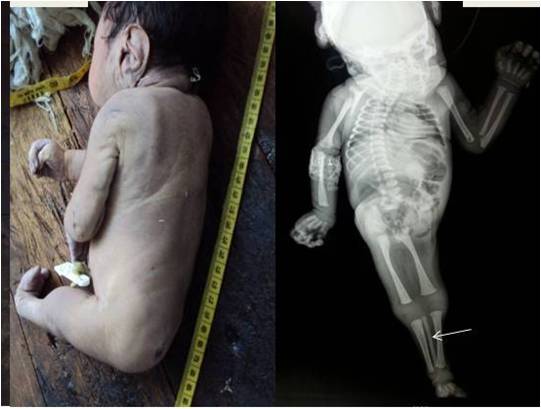Mermaids are real !! Sirenomelia: A case of mermaid baby
Keywords:
Sirenomelia, Mermaid, Polymalformative Syndrome
Abstract
We report a case of sirenomelia baby (mermaid syndrome) born to a thirty years old female at 36 weeks of gestation. It is a rare syndrome in which there is fusion of lower limbs.Classification of caudal regression syndrome (CRS) from sirenomelia is still debated. According to some authors, this syndrome should be classified separately from caudal regression syndrome and is likely to be the result of an abnormality taking place during the fourth gestational week, causing developmental abnormalities in the lower extremities, pelvis, genitalia, urinary tract and digestive organs. Despite recent progress in pathology, the etiopathogenesis of sirenomelia is still debated.References
1. Stanton MP, Penington EC, Huston JM. A surviving infant with Sirenomelia (Mermaid syndrome) associated with absent bladder. J Pediatr Surg. 2003;38(8):1266–8.
2. Banerjee A, Faridi MM, Banerjee TK, Mandal RN, Aggarwal A. Sirenomelia. Indian J Pediatr. 2003;70(7):589–91
3. Mohammed Z. Seidahmed, Omer B. Abdelbasit, Khalid A. Alhussein,Abeer M. Miqdad, Mohammed I. Khalil, Mustafa A. Salih, Sirenomelia and severe caudal regression syndrome.Saudi Med J 2014;35:S36-S43
4. Mills JL, Baker L, Goldman AS. Malformations in infants of diabetic mothers occur before the seventh gestational week. Implications for treatment. Diabetes.1979;28:292–293.
5. Anis Fadhlaoui, Mohamed Khrouf, Soumaya Gaigi, Fethi Zhioua, Anis Chaker. The Sirenomelia Sequence: A Case History. Clin Med Insights Case Rep. 2010; 3: 41–49.
6. Stocker JT, Heifetz SA. Sirenomelia. A morphological study of 33 cases and review of the literature. Perspect Pediatr Pathol 1987; 10: 7-50.
7. Stevenson RE. Limbs. In: Stevenson RE, Hall JG, editors. Human malformations and related anomalies. 2nd ed. New York (NY): Oxford University Press; 2006. p. 835-925.
8. Orioli IM, Amar E, Arteaga-Vazquez J, Bakker MK, Bianca S, Botto LD, et al. Sirenomelia: an epidemiologic study in a large dataset from the International Clearinghouse of Birth Defects Surveillance and Research, and literature review. Am J Med Genet C Semin Med Genet 2011; 157C: 358-373.
9. Duhamel B. From the mermaid to anal imperforation: the syndrome of caudal regression. Arch Dis Child 1961; 36: 152-5.
10. Jones KL. Philadelphia (PA): Elsevier Saunders; 2006. Smith's Recognizable Patterns of Human Malformation; pp. 728–729.
11. Stevenson RE, Jones KL, Phelan MC, et al. Vascular steal: the pathogenic mechanism producing sirenomelia and associated defects of viscera and soft tissues. Pediatrics.1986;78:451–7.
12. Adra A, Cordero D, Mejides A, et al. Caudal regression syndrome: Etio-pathogenesis, prenatal diagnosis and perinatal management. Obstet Gynecol Surv. 1994;49(7):508–76.
13. Dilorenzo M, Brandt ML, Veilleux A. Sirenomelia in an identical twin. A case report. J Pediatr Surg. 1991;26:1334.
14. Murphy JJ, Fraser GC, Blair GK. Sirenomelia: case of a surviving mermaid. J Ped Surg. 1992:27;(10):1265–8.
15. S.K. Samal, S. Rathod .Sirenomelia: The mermaid syndrome: Report of two cases. J Nat Sci Biol and Med. 2015; 6: 264–266
2. Banerjee A, Faridi MM, Banerjee TK, Mandal RN, Aggarwal A. Sirenomelia. Indian J Pediatr. 2003;70(7):589–91
3. Mohammed Z. Seidahmed, Omer B. Abdelbasit, Khalid A. Alhussein,Abeer M. Miqdad, Mohammed I. Khalil, Mustafa A. Salih, Sirenomelia and severe caudal regression syndrome.Saudi Med J 2014;35:S36-S43
4. Mills JL, Baker L, Goldman AS. Malformations in infants of diabetic mothers occur before the seventh gestational week. Implications for treatment. Diabetes.1979;28:292–293.
5. Anis Fadhlaoui, Mohamed Khrouf, Soumaya Gaigi, Fethi Zhioua, Anis Chaker. The Sirenomelia Sequence: A Case History. Clin Med Insights Case Rep. 2010; 3: 41–49.
6. Stocker JT, Heifetz SA. Sirenomelia. A morphological study of 33 cases and review of the literature. Perspect Pediatr Pathol 1987; 10: 7-50.
7. Stevenson RE. Limbs. In: Stevenson RE, Hall JG, editors. Human malformations and related anomalies. 2nd ed. New York (NY): Oxford University Press; 2006. p. 835-925.
8. Orioli IM, Amar E, Arteaga-Vazquez J, Bakker MK, Bianca S, Botto LD, et al. Sirenomelia: an epidemiologic study in a large dataset from the International Clearinghouse of Birth Defects Surveillance and Research, and literature review. Am J Med Genet C Semin Med Genet 2011; 157C: 358-373.
9. Duhamel B. From the mermaid to anal imperforation: the syndrome of caudal regression. Arch Dis Child 1961; 36: 152-5.
10. Jones KL. Philadelphia (PA): Elsevier Saunders; 2006. Smith's Recognizable Patterns of Human Malformation; pp. 728–729.
11. Stevenson RE, Jones KL, Phelan MC, et al. Vascular steal: the pathogenic mechanism producing sirenomelia and associated defects of viscera and soft tissues. Pediatrics.1986;78:451–7.
12. Adra A, Cordero D, Mejides A, et al. Caudal regression syndrome: Etio-pathogenesis, prenatal diagnosis and perinatal management. Obstet Gynecol Surv. 1994;49(7):508–76.
13. Dilorenzo M, Brandt ML, Veilleux A. Sirenomelia in an identical twin. A case report. J Pediatr Surg. 1991;26:1334.
14. Murphy JJ, Fraser GC, Blair GK. Sirenomelia: case of a surviving mermaid. J Ped Surg. 1992:27;(10):1265–8.
15. S.K. Samal, S. Rathod .Sirenomelia: The mermaid syndrome: Report of two cases. J Nat Sci Biol and Med. 2015; 6: 264–266

Published
2016-02-25
Issue
Section
Case Report
Authors who publish with this journal agree to the following terms:
- Authors retain copyright and grant the journal right of first publication with the work simultaneously licensed under a Creative Commons Attribution License that allows others to share the work with an acknowledgement of the work's authorship and initial publication in this journal.
- Authors are able to enter into separate, additional contractual arrangements for the non-exclusive distribution of the journal's published version of the work (e.g., post it to an institutional repository or publish it in a book), with an acknowledgement of its initial publication in this journal.
- Authors are permitted and encouraged to post their work online (e.g., in institutional repositories or on their website) prior to and during the submission process, as it can lead to productive exchanges, as well as earlier and greater citation of published work (See The Effect of Open Access at http://opcit.eprints.org/oacitation-biblio.html).




